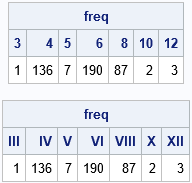Sometimes a little thing can make a big difference. I am enjoying a new enhancement of SAS/IML 15.1, which enables you to use a numeric vector as the column header or row header when you print a SAS/IML matrix. Prior to SAS/IML 15.1, you had to use the CHAR or PUTN function to manually apply a format to the numeric values. You could then use the formatted values as column or row headers. Now you can skip the formatting step.
A common situation in which I want to use numeric values as a column header is when I am using the TABULATE function to compute the frequencies for a discrete numerical variable. For example, the Cylinders variable in the Sashelp.Cars data set indicates the number of cylinders in each vehicle. You might want to know how many vehicles in the data are four-cylinder, six-cylinder, eight-cylinder, and so forth. In SAS/IML 15.1, you can use a numeric variable (such as the levels of the Cylinders variable) directly in the COLNAME= option of the PRINT statement, as follows:
proc iml; use Sashelp.Cars; read all var "Cylinders" into X; close; call tabulate(level, freq, X); /* count number of obs for each level of X */ /* New in SAS/IML 15.1: use numeric values as COLNAME= option to PRINT statement */ print freq[colname=level]; |

Prior to SAS/IML 15.1, you had to convert numbers to character values by applying a format. This is commonly done by using the CHAR function, which applies a W.D format. This technique is still useful, but optional. You can also use the PUTN function to apply any format you want, such as COMMA., DATE., TIME., and so forth. For example, if you like Roman numerals, you could apply the ROMAN. format!
labels = char(level, 2); /* apply w.d format */ print freq[colname=labels]; labels = putn(level, "ROMAN."); /* second arg is name of format */ print freq[colname=labels]; |

You can also use numeric values for the COLNAME= option to obtain row headers in SAS/IML 15.1. Sure, it's a small enhancement, but I like it!

3 Comments
Sometimes it's the small features that make a big impact. Learned two things in your post... using numeric variables in the COLNAME= option and the ROMAN SAS format!!! Didn't know about it, or perhaps it was more that I haven't had a need to use it ;-) but cool to know now!
Don't you mean you learned "II" things in the post? :-) Thanks for the comment! You might enjoy this article about applications of the ROMAN. format in SAS.
Ahha yes “II” things. This reminds me of a shirt I sometimes wear with the text... “There are 10 types of people in the world. Those that understand binary and those that don’t” It’s a great social experiment seeing the facial expressions and the occasional chat meeting new people.
Thanks for sharing your other ROMAN format post. Must have missed that one.